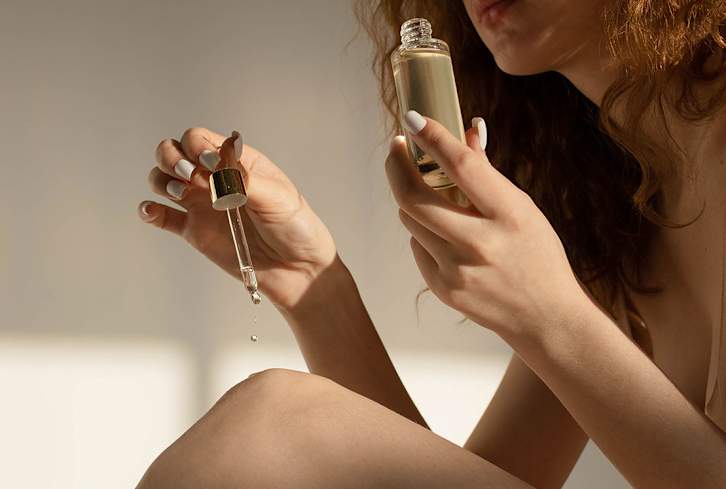Advertisement
How Body Temperature Changes Throughout Your Cycle + How To Deal


Have you ever experienced a heat panic? That overwhelming psychological stress that hits you after feeling too hot, too quickly? While commonly associated with menopause (thanks to mainstream media), hot flashes aren’t exclusive to it—or even to perimenopause, for that matter.
In reality, a woman’s body temperature naturally ebbs and flows throughout her hormone cycle. While an occasional hot flash might be annoying, these temperature shifts serve an important purpose. They help you spot your fertile window, which would be much harder without them.
Still, these fluctuations can be disruptive, affecting your sleep quality and altering your workout experiences. Your body temperature fluctuations are worth getting to know, so let’s dive in.
Editor’s note:
A closer look at how body temperature varies throughout a woman’s cycle
At the simplest level, think of estrogen as a cooling hormone and progesterone as a heating hormone. These hormones fluctuate throughout the menstrual cycle, causing varying degrees of temperature change in the body.
However, it's important to remember that other factors can also influence body temperature. While hormones set the stage, they don't have the final say in your body's temperature regulation.
Estrogen & progesterone are low during your period, so temperature is likely to remain stable.

Many people assume that PMS symptoms, including body temperature spikes, occur exclusively during your period, but that's not usually the case. During your period, both estrogen and progesterone levels are relatively low, which helps balance cooling and warming effects.
In fact, you might notice a drop in body temperature right before your period begins, says Angela Wilson, M.D., a board-certified OB/GYN at Montefiore Einstein Advanced Care. You can add that to the pros of period week.
In the rest of your follicular phase, estrogen & progesterone build slowly
Your period marks the first half of the follicular phase. In the second half, both estrogen and progesterone steadily increase as you approach ovulation, typically around day 14 of the menstrual cycle. Contrary to popular belief, ovulation doesn’t cause an immediate spike in temperature; the increase happens afterward.
Post-ovulation, body temperature rises, potentially causing hot flashes
A few days after ovulation, progesterone levels soar in the luteal phase, raising your body temperature and increasing the likelihood of hot flashes. These can occur at any time during this phase, but overnight hot flashes are particularly disruptive.
"Night sweats, which are hot flashes during sleep, are common and can disrupt sleep patterns," says Eboni January, M.D., a board-certified OB/GYN.
Besides sporadic hot flashes, your post-ovulation temperature changes could manifest as feeling hot more quickly when working out. “As your body heats up, your cardiovascular system has to work overtime to cool you down, redirecting blood from your muscles to the skin to help dissipate heat through sweating. This process can reduce your endurance, strength, and coordination,” says certified personal trainer for Centr Fitness Ingrid Clay.
Your physical strength and motivation are both subject to dips during the luteal phase as well, so give yourself some grace at the gym.
Remember: Since body temperature rises after ovulation, this shift can't be used to detect ovulation in real time. However, tracking these changes can help predict future ovulation and provide valuable insights into your cycle, Wilson explains.
The second half of the luteal phase should offer some relief
After progesterone and estrogen peak, a gradual fall will take place, offering some relief, both from hot flashes and a list of other PMS symptoms like mood shifts and trouble sleeping.
What about birth control & menopause?
So, if hormonal fluctuations cause a shift in body temperature, what does that mean for women on birth control? In short, it depends on what form of birth control you’re on.
For instance, “Monophasic birth control pills offer a steady amount of hormone throughout the cycle, keeping hormones and therefore temperature stable,” says board-certified reproductive endocrinologist at RMA New York Anate Brauer, M.D.
However, those on tri-phasic pills that vary in hormone levels to mimic a natural cycle may resonate more with the traditional fluctuations covered above.
As for menopause, you can break it up into three phases: Perimenopause, menopause, and postmenopause—all of which can include hot flashes due to hormonal shifts, especially a drop in estrogen (again, the cooling hormone).
Below, January details the three phases of menopause and how they relate to hot flashes:
- Perimenopause: “This phase can start several years before menopause, and women often experience the onset of hot flashes and night sweats.”
- Menopause: “Defined as 12 months without a menstrual period, this phase is marked by a peak in hot flashes due to significant hormonal changes.”
- Postmenopause: “While hot flashes often decrease in frequency and intensity after menopause, some women may continue to experience them for several years.”
How to support your hormones
So now that you know how your hormone fluctuations impact body temperature, let’s talk about what you can do to support the heat balance.
Movement
- Skip the hot workouts if needed: According to Clay, women experiencing hot flashes should do their best to avoid extreme temperatures, especially during a workout. Hot yoga and pilates, for example, can exacerbate the symptoms and cause more frustration than they’re worth.
- Consider outdoor activities: Instead, she suggests taking your workout into a cool environment, even outside during cooler parts of the day if you can.
- Try low-impact cardio: When it comes to cardio, more intense exercise is sure to spike your body temperature. Instead, opt for low-impact cardio. “Activities like walking, swimming, and cycling keep you fit without significantly raising your body temperature,” Clay says.
- Tone down your strength training when needed: During bouts of hot flashes, keep your strength training moderate. Rather than going all-out on weight and reps, incorporate light resistance training to build strength without causing excessive heat buildup, Clay says.
Nutrition
- Opt for cooling foods: When your body temperature is at its height, cooling foods will be your best friend. In general, these foods are higher in water, fiber, and alkalinity1, and can even be anti-inflammatory. A few to consider include cucumbers, coconut water, citrus fruits, and leafy greens.
- Stay hydrated: “Ensure adequate hydration before, during, and after exercise to aid in temperature regulation,” Clay says. She always tells her clients that once you’re thirsty, you’re already dehydrated.
Lifestyle
- Keep cool at home: If your hot flashes are impacting your sleep, do what you can during your wind-down routine to foster a cooler sleep environment. Crank up the AC or open a window, keep lightweight sheets on the bed, and opt for cooling sleepwear.
- Keep a cool-down kit on hand: Let’s be clear: There’s no shame in packing your bag with cooling essentials—a handheld fan, face mist, and so on. After all, it’s better to have it ready and not want it than want it and not have it.
- Manage stress when you can: Obviously, sometimes stress is unavoidable. In fact, stress and anxiety can even exacerbate your risk of hot flashes2. The solution? Have stress-relieving activities scheduled into your week—be it a five-minute daily meditation, exercise, long walks, and so on.
When body temperature becomes a concern
Temperature fluctuations are certainly normal and expected throughout the menstrual cycle. However, more severe hot flashes can be a sign that something else is happening within the body.
Below, January walks through a few things to ask your doctor about, should you be experiencing severe temperature shifts:
- Hormonal disorders: Conditions such as polycystic ovary syndrome (PCOS) can impact hormone levels and thus impact temperature shifts. These hot flashes may not follow the typical menstrual pattern and feel more sporadic, irregular, or intense.
- Hyperthyroidism: An overactive thyroid gland can increase metabolism, thus spiking body temperature.
- Infections: Unusual temperature spikes can also be symptom of a number of infections, such as urinary tract infections (UTIs), pelvic inflammatory disease (PID), etc.
- Pregnancy: Hormonal changes during pregnancy can also lead to increased body temperature.
A gentle reminder
The takeaway
Hormones like estrogen and progesterone play a large role in body temperature fluctuations. As these hormones ebb and flow, so will your body temperature, opening up the chance of hot flashes during the mid-luteal phase and menopause.
Watch Next
Enjoy some of our favorite clips from classes
Enjoy some of our favorite clips from classes
What Is Meditation?
Mindfulness/Spirituality | Light Watkins
Box Breathing
Mindfulness/Spirituality | Gwen Dittmar
What Breathwork Can Address
Mindfulness/Spirituality | Gwen Dittmar
The 8 Limbs of Yoga - What is Asana?
Yoga | Caley Alyssa
Two Standing Postures to Open Up Tight Hips
Yoga | Caley Alyssa
How Plants Can Optimize Athletic Performance
Nutrition | Rich Roll
What to Eat Before a Workout
Nutrition | Rich Roll
How Ayurveda Helps Us Navigate Modern Life
Nutrition | Sahara Rose
Messages About Love & Relationships
Love & Relationships | Esther Perel
Love Languages
Love & Relationships | Esther Perel
What Is Meditation?
Box Breathing
What Breathwork Can Address
The 8 Limbs of Yoga - What is Asana?
Two Standing Postures to Open Up Tight Hips
How Plants Can Optimize Athletic Performance
What to Eat Before a Workout
How Ayurveda Helps Us Navigate Modern Life
Messages About Love & Relationships
Love Languages
Advertisement

Research Shows Vitamin Deficiency May Up Alzheimer's Risk By 59%
Molly Knudsen, M.S., RDN

Do You Know Your Metabolic Age? Here's How To Find Out (& Improve It)
Mallory Creveling, CPT

Research Shows Vitamin Deficiency May Up Alzheimer's Risk By 59%
Molly Knudsen, M.S., RDN

Do You Know Your Metabolic Age? Here's How To Find Out (& Improve It)
Mallory Creveling, CPT

Research Shows Vitamin Deficiency May Up Alzheimer's Risk By 59%
Molly Knudsen, M.S., RDN

Do You Know Your Metabolic Age? Here's How To Find Out (& Improve It)
Mallory Creveling, CPT

4 Health Symptoms That Might Be Triggered By Mold (& What To Do About It)
William Cole, IFMCP, DNM, D.C.

Research Shows Vitamin Deficiency May Up Alzheimer's Risk By 59%
Molly Knudsen, M.S., RDN

Do You Know Your Metabolic Age? Here's How To Find Out (& Improve It)
Mallory Creveling, CPT

4 Health Symptoms That Might Be Triggered By Mold (& What To Do About It)
William Cole, IFMCP, DNM, D.C.













